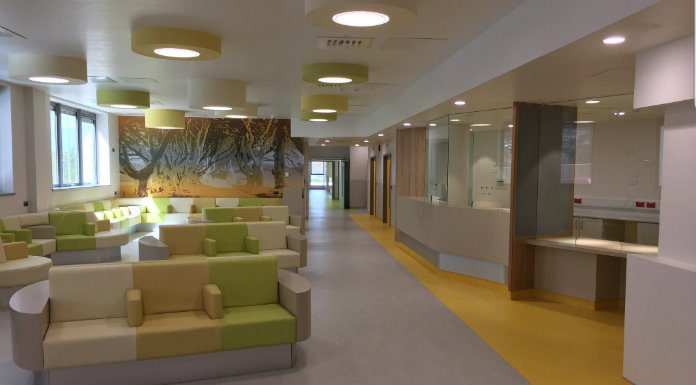The UL Hospitals Group has robustly defended measures taken in the run up to the opening of the new ED at the region’s main hospital.
It follows claims by the INMO, that it would be unsafe to open the unit as planned on Monday next, due to a number of concerns over staffing, plans to deal with trolley numbers and an insufficient number of practice runs.
After four years of waiting, the New Emergency Department at University Hospital Limerick is due to open on Monday next.
But with less than a week to go, the INMO is calling for the opening to be deferred, citing safety concerns.
Nurses say they have written to HSE management outlining critical patient safety issues which need to be addressed including an inadequate number of dry runs or simulations in the ED.
One of those has been held to date, last Wednesday.
They also say there are a number of inexperienced staff who feel ill-prepared, and say the new facility won’t deal with the trolley crisis there.
The INMO’s Mid-west representative, Mary Fogarty, has told Clare FM’s Morning Focus that it’s not safe to open the ED next Monday.
But in a statement to Clare FM, the UL Hospitals group says that there has been an unprecedented level of engagement over the past 18 months with nursing unions and that feedback from staff has been largely positive.
Over 90 new staff have been hired, and training has been provided.
While nurses say one dry run simply isn’t enough, the hospital’s statement also insists they have not been told this by nursing unions before now, and they describe it as “regrettable” that the INMO spoke publicly before writing to management.
Councillor Tom McNamara, who is the Chair of the HSE’s Regional Health Forum West, believes nurses concerns now need to be taken on board, and is urging all sides to take every step to ensure the new ED is safe:
Statement from the INMO:
Members of the Irish Nurses and Midwives Organisation (INMO), working in the Emergency Department at the University Hospital Limerick, have written to HSE management outlining critical patient safety issues which must be addressed, by the HSE, in advance of opening the new ED.
Nurses have looked forward, for years, to the day when they can work, and care for patients, in a top class environment. They welcome the new facility, but, having engaged with the HSE in advance of the opening, they remain deeply concerned at the following:
Final management proposals, received by the INMO on Monday evening May 22, propose to place a minimum of 24 admitted patients on trolleys and recliner chairs in the new Emergency Department. Furthermore the plans seek to embed, forever, the unacceptable concept of admitted patients on trolleys in this Emergency Department.
This is not progress for patients or nursing staff and is a retrograde approach as the opportunity for the new facility to reach its full potential cannot be realised. The INMO has proposed to management that the old Emergency Department should be utilised, as a separate area for admitted patients, but this has been rejected.
While the recruitment of nursing staff is ongoing, and this is acknowledged, our members continue to have serious concerns, regarding staffing/skill mix, arising from the following:
– The numbers of newly qualified staff rostered to work in the new unit;
– The numbers of newly qualified nursing staff recently arrived in Ireland still adapting to the new clinical environment; and
– The lack of staff, with an ED specialist qualification, available to work in the new unit; in the context of this unit being the second busiest ED in the country.
This situation is further compounded when it is noted that this department has lost nine highly skilled/experienced ED nurses, who held over 140 years of nursing experience between them, in the last number of months.
Against this background the proposed nursing skill mix is unsafe as newly qualified nurses are being tasked with senior nursing roles in emergency care. This requires management to fast track clinical skills facilitators for the new Emergency Department so as to ensure all nurses are supported as they increase their competence and experience in this hugely challenging clinical environment.
The HSE has undertaken only 1 dry run of the new facility, on last Wednesday, when a significant number of serious unsafe processes were identified. So far no feedback on same has been received by nurses.
This is a live service, it cannot be shut down, and consequently the transition must be seamless.
This requires at least 3/4 further dry runs to correct all faults identified.
Speaking this morning, INMO Industrial Relations Officer, Mary Fogarty said “Nurses are anxious to move to the state of the art facility as they have endured almost 10 years of a workplace which is unfit for purpose with an unacceptable level of overcrowding. Nursing representatives engaged with the HSE, since last September, and secured agreement on issues such as additional staff numbers, rosters, and allocation of staff to 6 independent location, etc
However, critical issues, raised repeatedly by the INMO, remain unresolved. Nurses refer to their Nursing & Midwifery Board of Ireland Code of Professional Conduct & Ethics which requires them to report to management any safety concerns and/or issues which negatively impact on their ability to practice safely. Patients and nurses have waited a long time for this new facility, it is incumbent, therefore, on the HSE to address and resolve all outstanding issues in advance of opening”.
Statement from the UL Hospitals Group
An unprecedented level of engagement – under the auspices of an independently chaired forum involving management and both nursing unions INMO & SIPTU – has taken place over the past 18 months regarding the Emergency Department and in particular the move to the new Emergency Department.
A comprehensive document addressing issues raised by the unions was developed by management at this forum. This document included:
· the allocation of the additional 30 nursing WTEs
· A clinical skills competency document for the allocation of staff to each area
· Patient Flow for the admitted patients
In addition there has been significant recruitment of over 90 new staff (all grades) to the new department with the new nursing staff undertaking an intensive induction programme. This was also advised to the unions through the forum. The induction programme was unique for nursing staff commencing in the health service and was facilitated by the dedicated Emergency Department Clinical Skills Facilitator along with colleagues from the Nurse Planning and Development Unit.
Given the worldwide shortage of nurses, we are delighted to have been able to recruit the staff to allow the opening of the department. Some of these staff have come to Ireland from Europe and we welcome them to our hospital and to the region. Recognising that our new staff were coming from overseas into a new healthcare system, we took the decision to bring the staff in a number of months in advance, with many starting in March and the remaining staff commencing in April. This is unprecedented in the health service. We also put a mentorship programme in place for newly appointed nurses commencing in the Emergency Department.
The new department will also have 15 additional Health Care Assistants to support patient care. They have also undergone a dedicated induction programme.
The move to the new Emergency Department has been a significant project for the group and has been managed by a dedicated project manager.
Key staff have been inducted and trained and orientations have been running twice daily for over a month.
A key element of the plan was a Dry Run ahead of the opening of the ED. UL Hospitals is unaware of any such exercise having been attempted ahead of an ED opening in Ireland before. The Dry Run has been part of the plan since September 2016 and it took place on Wednesday last, May 17th. At no point has the project team or management been notified by staff representatives that holding a single dry run was inadequate.
The object of the Dry Run was to accurately simulate a normal day’s operation in the ED; to properly test the new department’s capabilities; to confirm that the design and processes would efficiently maximise patient flow and to accurately capture the results.
Just under 100 feedback forms were completed by staff and volunteers on the day. The balance of the feedback as a whole was very positive. The three most significant negative issues identified were ICT issues, acoustics in the main reception and signage. All of these are being resolved before opening. The balance of the feedback as a whole was very positive.
The CT scanner in the Resus area is currently being commissioned and will also need to complete the EPA licensing process. This means that it may not be operational for another two to three weeks. Currently patients in the ED who require a CT scan are transferred to the radiology department and this will continue until the new CT in Resus is operational.
Where a patient requires a CT, this will require a registrar to accompany that patient on their journey to radiology and back. From the Dry Run we know that this will require the absence from the Department of a registrar of between 13 to 29 minutes, depending on the degree of mobility of the patient. There is a plan in place to manage this staffing issue through rostering.
Hospital management will continue to work with staff over the coming days to ensure that the move to the new department runs smoothly.
It is regrettable that the INMO has not raised its concerns with hospital management before raising them in the media.








